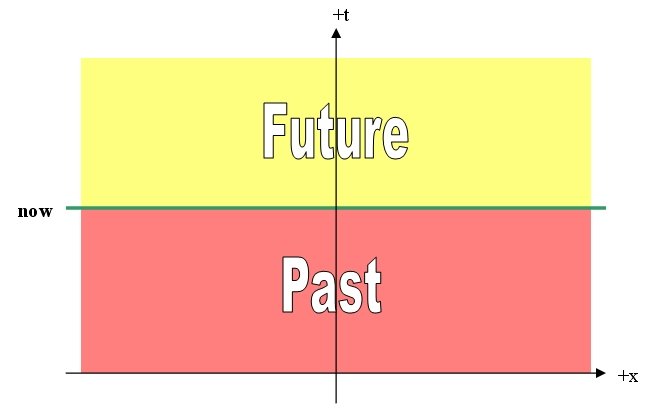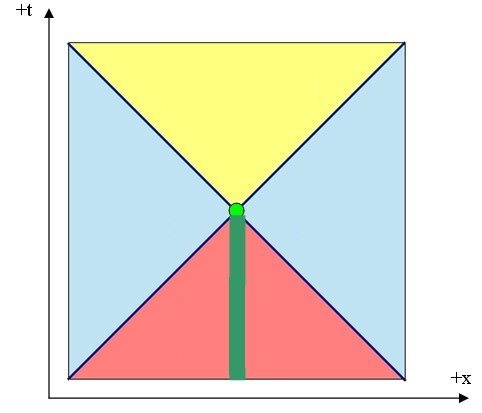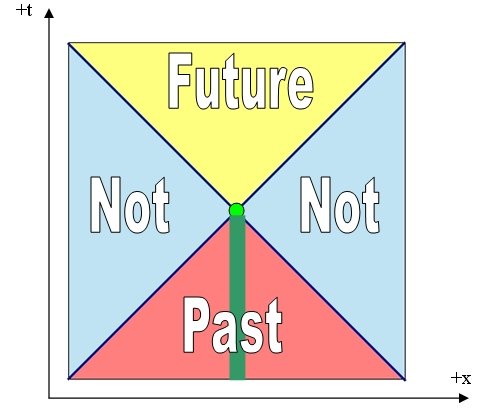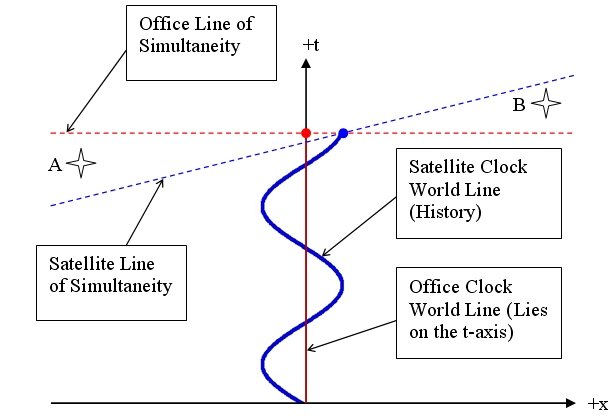|
"Now"... its not what it was...
Let's use spacetime diagrams, introduced in the Simultaneity Situation page, to think about the nature of "now". The past is gone and the future has not arrived so "now" is the only time available to carry out actions. Classically, before we had to think about relativity effects, we thought of "now" as a slice through the universe, separating past from future throughout all of space, a surface on which all events are simultaneous, sort of as shown below where "now" extends throughout all of space at a constant time coordinate. Of course the diagram only shows one dimension of a three dimensional constant time slice.
 With the understanding of the relativity principle the picture got more complicated. With that we have to consider a thing called a light cone, or null cone. Look at the spacetime diagram below. It is arranged so that the same units are applied to both the time and space axes, meters for example. Notice that we can think of the speed of light as just being a conversion factor between time and distance.
With time and distance both in meters, what would be the worldline of a photon of light arriving at the green object sitting at the uptime terminus of its worldline? Well it would be a line coming in from the lower right or left at a 45 degree angle. The below image shows a spacetime diagram including the worldlines of four photons. One is outgoing to the right from the green object . One is outgoing to the left. One is incoming from the left. The last is incoming from the right. The first two photon worldlines form a 90 degree angle opening upward. The second two form a 90 degree angle opening downward. The four photon worldlines divide spacetime into four regions. In the two dimensional spacetime diagram we are using here, the regions are 2D-triangles. If we add a dimension the regions are 3D-cones. Including the third spatial dimension the regions are 4D-solids (hard to visualize). Because we used light photons to establish these regions we get the name "light cone". Any objects traveling at the speed of light that arrive at or depart from our object have worldlines that lie on the light cones. All material objects, like birdshot or boxcars, that are absorbed or emitted by our object, by the rules of relativity must travel slower than the speed of light so their world lines will lie within the lower or upper light cone respectively.
 Let's now imagine that we go outside on a starry night and look up at the sky. All the starlight that is absorbed by our eyes is coming from the past, the visible light from a few years to a few million years ago. Light too faint to register with us may be coming from billions of years ago. In whatever direction we look, the light is arriving from the past. Now pull out your flashlight and turn it on. In whatever direction you point it, the emitted light is travelling into the future. In something under a second and a half photons from your flashlight would arrive at the moon.
Now take a look at your computer screen. The light from the screen absorbed by your eyes is also coming from the past, in this case around a nanosecond ago. Now open 'notepad' and poke the ! key on the computer. You have just sent information into the future and confirmed that it was there when you arrived at the time the symbol appeared on the screen, and look... it is still there. OK you can close 'notepad' now.
These little exercises demonstrate that the pink region of spacetime diagram, from which all information comes to the green object, can be labeled "Past". The yellow region, where all information goes from the green object, can be labeled "Future". Because no information can travel faster than the speed of light, nothing that happens in the blue regions can have any effect on the green object. Neither can the green object cause anything to happen in the blue regions. That whole region of spacetime, half of the total volume, is effectively isolated from our object, being not in our object's past or its future. In a very real sense only half of the spacetime volume of the universe exists for us.
 The region labeled "Past" contains all the volume of spacetime from which events had any chance of causing an effect on the green object at its spacetime location. Events outside the "Past" region simply did not have time to communicate with the object, given the fixed speed of light demanded by relativity. The region labeled "Future" contains the volume of spacetime where any action by the green object at its spacetime location might have caused an event. Our object is too late to cause any events outside the "Future" area. The two areas that are not "Past" nor "Future" contain events that cannot have an effect on our object, nor be affected by it. Those events are separated from our object by a spacelike interval.
Let's revisit the spacetime diagram from the previous page, where we investigated lines of simultaneity. Intuitively I would be inclined to say that in relativity a line of simultaneity would represent the spacetime location of "now", replacing the classical surface on which all events are simultaneous.
 Notice that the two events A and B, marked by stars, lie clearly at angles greater than 45 degrees from the t-axis, meaning that they are separated from both objects by a spacelike interval, placing them in that part of spacetime that is neither in the past or the future for either object. It appears that our intuitive use of a line of simultaneity to represent "now" would be ill advised. Considering relativity, it seems that the only place where an objects past and future are joined is at the object's location so it must be only there that "now" exists for that object. Away from the object's spatial location is this neither past nor future region that effectively does not exist for the object. So we are faced with a "now" that is not a surface in spacetime at all, but a powder of points, one for each object under consideration. I am not sure that this is any great improvement in my understanding of nature. It is not clear to me at the moment what all the implications of this notion might be. As most scientific studies conclude, "More study is required". It is a rule, part of the "scientist full employment" program.
At least this new point of view resolves the problem of ambiguity in the order of events with which we were faced at the end of the previous page. The order of events separated from the observer by spacelike intervals is immaterial since the events are outside the possibility of observation. The order of events separated by timelike intervals from the observer is fixed, regardless of the relative motion of the observer.
You can convince yourself of the latter assertion by marking the edge of a piece of paper with three spots with about an inch between them and holding the center spot over point B in the below animated diagram. Keeping the line of spots near enough to vertical so that they all fall in the gray shaded area, meaning they are lightlike separated, you will see that white line of the animation, that sweeps up the screen, always encounters the spots on the paper in the same order. Microsoft Internet Explorer for XP (IE 8) simply cannot handle animated GIF files. If you run XP, try the free Firefox browser. It is generally better than Microsoft's in many respects.
Well, I think I have gone on long enough for this page. I will save consideration of a powdered "now" for next time.
|




